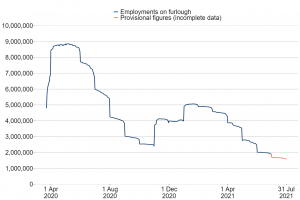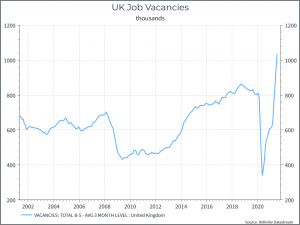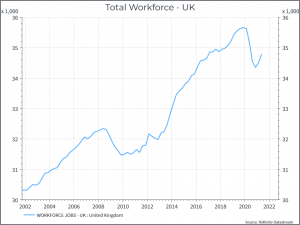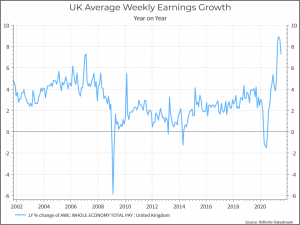What are we talking about? This week saw the end of the furlough scheme in the UK, at least for now. The scheme provided critical support for businesses and employees during the pandemic. The estimated cost, so far, to the Treasury is in the region of £70 billion. The latest data indicated that there were still somewhere north of 1 million workers covered by the scheme (as the chart below from HMRC indicates).

The Bank of England commented, in its recent statement, that the number of furloughed jobs has continued to decline but at a much slower pace than they had expected.
A functioning labour market? Labour markets, particularly in the UK and the US, are a bit strange at present. Basically, employers can’t find workers, but the labour market still hasn’t recovered. The two charts below illustrate the point. The first shows UK job vacancies, currently at an all-time high (at least since they started collecting the data).

The second chart shows the total workforce over the past twenty years. It suggests that we’ve begun to see a labour market recovery, but we’ve still got some way to go before we get back to where we were pre-COVID.

This combination suggests a bit of a mismatch between the demand for workers and their availability, and lots of surveys tell a similar story. More importantly, we’ve seen this reflected in wage growth (economists everywhere breathe a sigh of relief). The chart below shows weekly earnings growth in the UK – it’s had a pretty healthy spike over the past few months.

Where does this get us? On balance, the data seems to support the move to end the furlough scheme. Demand for workers is high, wages have been increasing – why have pay to keep people out of the workforce?
It’s never quite so straightforward as that. The economic environment remains challenging – and there’s always potential for further short-term disruption as the furlough scheme comes to an end. And it’s not guaranteed that ending the furlough scheme will solve skills shortages in the economy. You’d guess that there aren’t lots of HGV drivers being paid to sit at home. But there’s a mismatch between supply and demand in the labour market, and that seems like something worth fixing.





